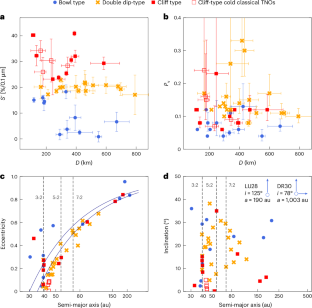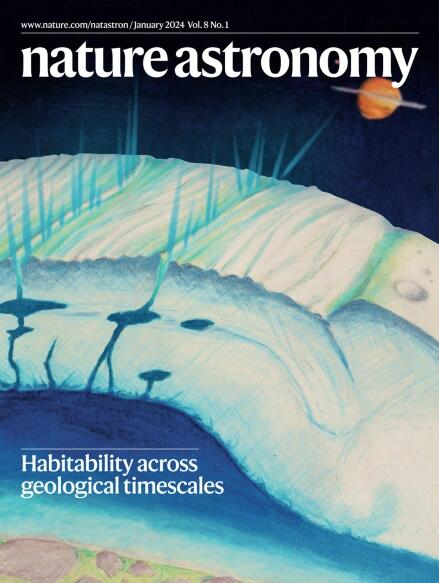A JWST/DiSCo-TNOs portrait of the primordial Solar System through its trans-Neptunian objects
IF 12.9
1区 物理与天体物理
Q1 ASTRONOMY & ASTROPHYSICS
引用次数: 0
Abstract
The detection of molecules on the coldest and outermost objects in our Solar System has long been limited by the terrestrial atmosphere and sensitivity of the available instrumentation. However, near-infrared observations by the James Webb Space Telescope have provided an unprecedented view of the molecular diversity on the surfaces of trans-Neptunian objects (TNOs). Using the low spectral resolution PRISM mode on the near-infrared spectrograph as part of the Cycle 1 large programme, ‘Discovering the Surface Composition of trans-Neptunian objects’, we report the detection of several molecular ices throughout the TNO population, including H2O, CO2, 13CO2, CO, CH3OH and complex molecules and refractory materials containing aliphatic C–H, C≡N, O–H and N–H bonds. As a result of the imprint that these molecules leave on the spectra, three main compositional groups consistently emerge from multiple independent cluster analyses. Our results unlock the long-standing question of the interpretation of colour diversity, providing the much-needed compositional information. The marked separation of the three spectral clusters reveals sharp variations in the surface molecular constituents. The C/O and (CH + NH)/(C + O) ratios on the surface of TNOs are the primary indicators of the spectral differences among the three TNO compositional groups observed. We propose that these objects are fossil remnants of icy planetesimals, and that the three compositional groups provide a picture of the ice retention lines in the Solar System that likely occurred in the outer protoplanetary disk, possibly just before a major planetary migration. The icy surface compositions, as revealed by JWST, of small bodies beyond the orbit of Neptune can be classified into three groups that can be related to the ice retention lines in the early Solar System, possibly before the planets migrated.


JWST/DiSCo-TNOs 通过跨海王星天体描绘原始太阳系
长期以来,探测太阳系最冷和最外层物体上的分子一直受到地球大气和现有仪器灵敏度的限制。然而,詹姆斯·韦伯太空望远镜的近红外观测为外海王星天体(TNOs)表面的分子多样性提供了前所未有的视角。作为Cycle 1大项目“发现海王星外天体的表面组成”的一部分,我们使用近红外光谱仪上的低光谱分辨率PRISM模式,报告了在整个TNO族中检测到的几种分子冰,包括H2O, CO2, 13CO2, CO, CH3OH和含有脂肪族C - h, C≡N, O-H和N - h键的复杂分子和难熔材料。由于这些分子在光谱上留下的印记,从多个独立的聚类分析中一致地出现了三个主要的成分群。我们的研究结果解开了解释颜色多样性的长期问题,提供了急需的成分信息。三个光谱簇的明显分离揭示了表面分子成分的急剧变化。TNO表面的C/O和(CH + nhh)/(C + O)比值是表征三组TNO光谱差异的主要指标。我们提出,这些物体是冰冷的星子的化石残留物,这三个成分组提供了太阳系中冰保留线的图片,可能发生在外原行星盘,可能就在一次主要的行星迁移之前。
本文章由计算机程序翻译,如有差异,请以英文原文为准。
求助全文
约1分钟内获得全文
求助全文
来源期刊

Nature Astronomy
Physics and Astronomy-Astronomy and Astrophysics
CiteScore
19.50
自引率
2.80%
发文量
252
期刊介绍:
Nature Astronomy, the oldest science, has played a significant role in the history of Nature. Throughout the years, pioneering discoveries such as the first quasar, exoplanet, and understanding of spiral nebulae have been reported in the journal. With the introduction of Nature Astronomy, the field now receives expanded coverage, welcoming research in astronomy, astrophysics, and planetary science. The primary objective is to encourage closer collaboration among researchers in these related areas.
Similar to other journals under the Nature brand, Nature Astronomy boasts a devoted team of professional editors, ensuring fairness and rigorous peer-review processes. The journal maintains high standards in copy-editing and production, ensuring timely publication and editorial independence.
In addition to original research, Nature Astronomy publishes a wide range of content, including Comments, Reviews, News and Views, Features, and Correspondence. This diverse collection covers various disciplines within astronomy and includes contributions from a diverse range of voices.
 求助内容:
求助内容: 应助结果提醒方式:
应助结果提醒方式:


